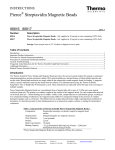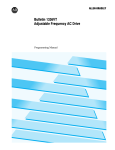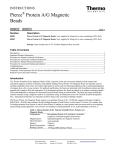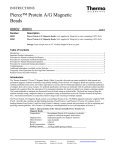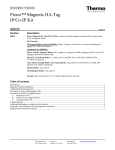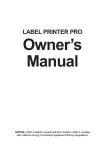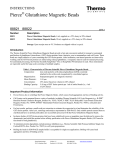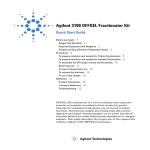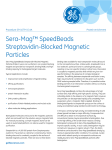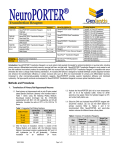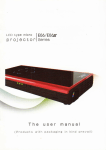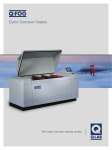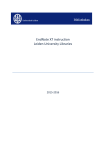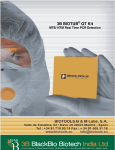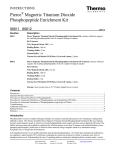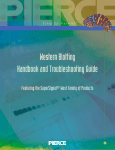Download Pierce Direct Magnetic IP/Co
Transcript
INSTRUCTIONS Pierce® Direct Magnetic IP/Co-IP Kit 88828 2321.1 Number Description 88828 Pierce Direct Magnetic IP/Co-IP Kit, contains sufficient reagents to perform 40 reactions using 25µL of magnetic beads Kit Contents: Pierce NHS-Activated Magnetic Beads, 1mL supplied at 10mg/mL in N,N-dimethylacetamide (DMAC) IP Lysis/Wash Buffer, 2 × 50mL, pH 7.4, 0.025M Tris, 0.15M NaCl, 0.001M EDTA, 1% NP40, 5% glycerol Elution Buffer, 5mL, pH 2.0 Neutralization Buffer, 0.5mL, pH 8.5 Quenching Buffer, 25mL, 3M ethanolamine, pH 9.0 Borate Buffer, 1mL, 0.67M BupH™ Borate Buffer Pack, 0.05M sodium borate, pH 8.5 when dissolved in a final volume of 500mL of ultrapure water Lane Marker Sample Buffer, Non-reducing, (5X), 5mL, 0.3M Tris•HCl, 5% SDS, 50% glycerol, lane marker tracking dye; pH 6.8 Note: Before using, refer to the product label for the expiration date. Storage: Upon receipt store at 4°C. Product shipped with an ice pack. Table of Contents Introduction ................................................................................................................................................................................. 1 Procedure Summary..................................................................................................................................................................... 2 Important Product Information .................................................................................................................................................... 2 Procedure for Mammalian Cell Lysis .......................................................................................................................................... 3 Manual Procedure for the Pierce Direct Magnetic IP/Co-IP Kit ................................................................................................. 3 Automated Procedure for the Pierce Direct Magnetic IP/Co-IP Kit ............................................................................................ 5 Troubleshooting ........................................................................................................................................................................... 6 Additional Information ................................................................................................................................................................ 7 Related Thermo Scientific Products ............................................................................................................................................ 7 Introduction The Thermo Scientific Pierce Direct Magnetic IP/Co-IP Kit enables efficient antigen immunoprecipitations (IP) and coimmunoprecipitations (co-IP). The activated magnetic beads contain N-hydroxysuccinimide (NHS) functional groups, which react with primary amines on antibodies to form stable amide linkages. The antibody is first coupled to the NHS-activated magnetic beads in an amine-free buffer. The antibody-coupled beads are washed to remove any non-covalently bound antibody and quenched. The prepared beads are incubated with the antigen sample, washed to remove non-bound material and eluted in a low-pH elution buffer to dissociate the antigen. The kit includes optimized buffers that minimize nonspecific binding and maximize antigen yield. Lane marker sample buffer is included for preparing samples for SDS-PAGE analysis. The beads are manually removed from the solution with a magnetic stand or by automation using an instrument such as the Thermo Scientific KingFisher Flex System. Automated instruments are especially useful for large-scale screenings of multiple samples. Pierce Biotechnology PO Box 117 (815) 968-0747 3747 N. Meridian Road Rockford, lL 61105 USA (815) 968-7316 fax www.thermoscientific.com/pierce Table 1. Characteristics of Thermo Scientific Pierce NHS-Activated Magnetic Beads. Composition: N-hydroxysuccinimide (NHS) functional groups on a blocked magnetic bead surface Magnetization: Superparamagnetic (no magnetic memory) Mean Diameter: 1μm (nominal) Density: 2.0g/cm3 Bead Concentration: 10mg/mL in DMAC Binding Capacity: ≥ 26μg of rabbit IgG/mg of beads Procedure Summary 1. Wash the beads with ice-cold 1mM HCl. 2. Bind antibody to the beads for 30-60 minutes. 3. Wash the beads twice with Elution Buffer. 4. Quench the reaction for 30-60 minutes with Quenching Buffer. 5. Wash the beads once with Modified Borate Buffer and once with IP Lysis/Wash Buffer. 6. Incubate cell lysate with antibody-bound beads for 2 hours at room temperature or overnight at 4ºC. 7. Wash the beads twice with IP Lysis/Wash Buffer and once with ultrapure water. 8. Elute bound antigen. Important Product Information • Magnetic beads are moisture-sensitive. To protect the beads, cap the bottle immediately after removing the slurry and wrap lab film around the cap before storing at 4ºC. • Do not centrifuge, dry or freeze the magnetic beads. Bead aggregation and loss of binding activity may result from using these methods. • Estimate the amount of protein coupled to the magnetic beads with a protein assay (e.g., Thermo Scientific Pierce 660nm Protein Assay, Product No. 22660 and 22662) and subtract the amount of flow-through protein from the loaded protein. To measure the amount of protein on the bead directly, use the Thermo Scientific Pierce Micro BCA Protein Assay (Product No. 23235, on our website see Tech Tip #75: Measure protein bound to Pierce NHS-Activated Magnetic Beads). • For coupling antibodies to magnetic beads, ensure the antibody storage solution does not contain a protein stabilizer (e.g., BSA, gelatin), which inhibits coupling of the antibody to the beads. Remove protein stabilizers with the Thermo Scientific Pierce Antibody Clean-up Kit (Product No. 44600, on our website see Tech Tip #55: Remove BSA and gelatin from antibody solutions using Melon Gel). • Primary amine-containing buffers (e.g., Tris and glycine) inhibit coupling of protein to the magnetic beads. Remove primary amine-containing buffer using dialysis (e.g., Thermo Scientific Slide-A-Lyzer G2 Dialysis Cassettes, 10K MWCO, 3mL, Product No. 87730) or desalting (e.g., Thermo Scientific Zeba Spin Desalting Columns, 7K MWCO, 0.5mL, Product No. 89882). • For optimal results, use an affinity-purified antibody. Although serum may be used, the antibody specific for the antigen of interest may comprise only 1-2% of the total IgG in the serum sample, resulting in low antigen recovery. • The IP Lysis/Wash Buffer has been tested on representative cell types including, but not limited to, the following cell lines: HeLa, Jurkat, A431, A459, MOPC, NIH 3T3, and U2OS. Typically, 106 HeLa cells yield ~10mg of cell pellet and ~3µg/µL or 300µg when lysed with 100µL of IP Lysis/Wash Buffer. • To minimize protein degradation, include protease inhibitors (e.g., Thermo Scientific Halt Protease Inhibitor Single-Use Cocktail EDTA-free, Product No. 78425) in the preparation of cell lysates. • The IP Lysis/Wash Buffer is compatible with Thermo Scientific Pierce BCA Protein Assay (Product No. 23225). • Optimal time for low-pH elution is 5 minutes; if the desired amount of antigen is not obtained, then a second 5 minute low-pH elution may be performed to remove additional bound antigen. Pierce Biotechnology PO Box 117 (815) 968-0747 3747 N. Meridian Road Rockford, lL 61105 USA (815) 968-7316 fax 2 www.thermoscientific.com/pierce Procedure for Mammalian Cell Lysis A. Additional Materials Required • Phosphate-buffered saline (PBS, 100mM sodium phosphate, 100mM NaCl; pH 7.2; Product No. 28372) • Cultured cells Protocol I: Lysis of Cell Monolayer (Adherent) Cultures 1. Carefully remove culture medium from confluent cells. 2. Wash the cells once with PBS. 3. Add ice-cold IP Lysis/Wash Buffer to the cells (see Table 2) and incubate on ice for 5 minutes with periodic mixing. Table 2. Suggested volume of IP Lysis/Wash Buffer to use for different standard culture plates. Plate Size/Surface Area Volume of IP Lysis/Wash Buffer 100 × 100mm 500-1000μL 100 × 60mm 250-500μL 6-well plate 200-400μL per well 24-well plate 100-200μL per well 4. Transfer the lysate to a microcentrifuge tube and centrifuge at ~13,000 × g for 10 minutes to pellet the cell debris. 5. Transfer supernatant to a new tube for protein concentration determination and further analysis. Protocol II: Lysis of Cell Suspension Cultures 1. Centrifuge the cell suspension at 1000 × g for 5 minutes to pellet the cells. Discard the supernatant. 2. Wash cells once by suspending the cell pellet in PBS. Centrifuge at 1000 × g for 5 minutes to pellet cells. 3. Add ice-cold IP Lysis/Wash Buffer to the cell pellet. Use 500μL of IP Lysis/Wash Buffer per 50mg of wet cell pellet (i.e., 10:1 v/w). If using a large amount of cells, first add 10% of the final volume of IP Lysis/Wash Buffer to the pellet and pipette the mixture up and down to mix. Add the remaining volume IP Lysis/Wash Buffer to the cell suspension. 4. Incubate lysate on ice for 5 minutes with periodic mixing. Remove cell debris by centrifugation at ~13,000 × g for 10 minutes. 5. Transfer supernatant to a new tube for protein concentration determination and further analysis. Manual Procedure for the Pierce Direct Magnetic IP/Co-IP Kit A. Additional Materials Required • Magnetic stand (e.g., Thermo Scientific Magnabind Magnet for 6 × 1.5mL microcentrifuge tubes, Product No. 21359) • 1.5mL microcentrifuge tubes • Ice-cold 1mM hydrochloric acid • Coupling antibody • Antigen sample for IP • Ultrapure water Pierce Biotechnology PO Box 117 (815) 968-0747 3747 N. Meridian Road Rockford, lL 61105 USA (815) 968-7316 fax 3 www.thermoscientific.com/pierce B. Coupling Antibodies to the NHS-Activated Magnetic Beads Note: The following protocol is optimized for coupling 5µg of antibody to 25µL of beads, but can be used for coupling 210µg of antibody. This procedure can be scaled up to prepare larger quantities of antibody-coupled beads. 1. Vortex the bottle of NHS-activated magnetic beads to obtain a homogeneous suspension. Add 25µL of beads into a microcentrifuge tube. Place the tube on a magnetic stand and collect the beads for 1 minute. Remove and discard the storage solution. 2. Add 400µL of ice-cold 1mM HCl to the tube and gently vortex to mix for 5 seconds. Collect the beads on a magnetic stand. Remove and discard the supernatant. 3. Prepare antibody solution by diluting antibody stock into 10µL of Borate Buffer (0.67M) and adding ultrapure water to bring the final volume to 100µL. The final concentration of antibody will be 5µg/100µL and the final concentration of Borate Buffer will be 0.067M. Note: Adjust the antibody solution for antibody amounts other than 5µg per IP. 4. Add 100µL of prepared antibody solution to the beads. Gently mix and incubate on a rotating platform for 30-60 minutes at room temperature; vortex the beads every 10-15 minutes during incubation to ensure that the beads remain in suspension. 5. Collect the beads with a magnetic stand. Remove the flow-through and save for analysis. 6. Add 100µL of Elution Buffer and gently vortex or invert to mix. Collect the beads on a magnetic stand. Remove and discard the supernatant. Repeat this wash once. Note: The Elution Buffer removes non-covalently bound antibody. 7. Add 500µL of Quenching Buffer to the beads. Gently mix and incubate on a rotating platform for 30-60 minutes. 8. Collect the beads with a magnetic stand. Remove and discard the supernatant. 9. Prepare 0.5mL of Modified Borate Buffer for each IP reaction by diluting 25µL of IP Lysis/Wash Buffer with 475µL of Borate Buffer (prepared from a Thermo Scientific BupH Borate Buffer Pack, contents dissolved in a final volume of 500mL ultrapure water). 10. Add 500µL of Modified Borate Buffer prepared in Step 9 to the tube and gently vortex or invert to mix. Collect the beads on a magnetic stand. Remove and discard the supernatant. 11. Add 500µL of IP Lysis/Wash Buffer and gently vortex or invert to mix. Collect the beads on a magnetic stand. Remove and discard the supernatant. C. Antigen Immunoprecipitation 1. Dilute the lysate solution (see the Procedure for Mammalian Cell Lysis Section) with IP Lysis/Wash Buffer to 1-2mg/mL. 2. Add 500µL of diluted lysate solution to the tube containing the antibody-coupled magnetic beads and incubate for 2 hours at room temperature on a rotator or mixer. Gently vortex the beads every 15-30 minutes during incubation to ensure the beads stay in suspension. 3. Collect the beads on a magnetic stand. Remove the unbound sample and save for analysis. 4. Add 500µL of IP Lysis/Wash Buffer to the tube and gently vortex or invert to mix. Collect the beads on a magnetic stand. Remove and discard the supernatant. Repeat this wash once. 5. Add 500µL of ultrapure water to the tube and gently vortex or invert to mix. Collect the beads on a magnetic stand. Remove and discard the supernatant. 6. Add 100µL of Elution Buffer to the tube. Incubate for 5 minutes at room temperature on a rotator or mixer. Magnetically separate the beads and save the supernatant containing the target antigen. To neutralize the low pH, add 10µL of Neutralization Buffer for each 100µL of eluate. Note: If the desired amount of antigen is not obtained, then a second 5 minute low-pH elution can be performed to recover additional bound antigen. Pierce Biotechnology PO Box 117 (815) 968-0747 3747 N. Meridian Road Rockford, lL 61105 USA (815) 968-7316 fax 4 www.thermoscientific.com/pierce Automated Procedure for the Pierce Direct Magnetic IP/Co-IP Kit A. Additional Materials Required • KingFisher® Flex System with 96 deep well head (Product No. 5400630) or KingFisher 96 System (Product No. 5400500) • Thermo Scientific Microtiter Deep Well 96 Plates, V-bottom, polypropylene (100-1000µL; Product No. 95040450) • KingFisher Flex 96 Tip Comb for Deep Well Magnets (Product No. 97002534) • 1.5mL microcentrifuge tubes • Ice-cold 1mM HCl • Coupling antibody • Antigen sample for IP • Ultrapure water B. Automated Protocol for Antibody Coupling and Antigen Immunoprecipitation Note: The following protocol is designed for use with the KingFisher Flex or KingFisher 96 Instrument. The protocol can be modified according to your needs using the Thermo Scientific BindIt Software provided with the instrument. Note: Lysate solution in the protocol is from the Procedure for Mammalian Cell Lysis Section. 1. Enter the “Direct Immunoprecipitation” protocol from Table 3 into the BindIt® Software on an external computer. 2. Transfer the protocol to the KingFisher Flex or KingFisher 96 Instrument from an external computer. See the BindIt Software user manual for detailed instructions on importing protocols. 3. Set up plates according to Table 3. Table 3. Pipetting instructions for the automated protocol using Microtiter Deep Well 96 Plates. Plate # Plate Name 1 Beads Content Volume NHS-Activated Beads 25µL Ice-cold 1mM HCl 175µL Time/Speed Collect Beads 2 HCl Wash Ice-cold 1mM HCl 400µL 5 seconds/Slow 3 Coupling Antibody Sample 100µL 30 minutes/Slow 4 Elution Buffer Wash 1 Elution Buffer 100µL 10 seconds/Slow 5 Elution Buffer Wash 2 Elution Buffer 100µL 10 seconds/Slow 6 Quench Quenching Buffer 500µL 30 minutes/Slow 7 Wash 1 Modified Borate Buffer 500µL 30 seconds/Slow 8 Wash 2 IP Lysis/Wash Buffer 500µL 30 seconds/Slow 9 Bind Lysate solution 500µL 2 hours/Slow 10 IP Wash 1 IP Lysis/Wash Buffer 500µL 30 seconds/Slow 11 IP Wash 2 IP Lysis/Wash Buffer 500µL 30 seconds/Slow 12 IP Wash 3 Purified Water 500µL 30 seconds/Slow 13 Elution Elution Buffer 100µL 5 minutes/Slow 14 Tip Plate KingFisher Flex 96 Tip Comb for Deep Well Magnets - - Pierce Biotechnology PO Box 117 (815) 968-0747 3747 N. Meridian Road Rockford, lL 61105 USA (815) 968-7316 fax 5 www.thermoscientific.com/pierce 4. Select the protocol using the arrow keys on the instrument keypad and press Start. See the KingFisher Flex or KingFisher 96 Instrument user manual for detailed information. 5. Slide open the door of the instrument’s protective cover. 6. Load the Tip Plate (plate #14) and press Start. The instrument places the Tip Comb onto the magnet head. 7. Remove the Tip Plate. 8. Load plates #1-8 into the instrument according to the protocol requests; place each plate in the same orientation. Confirm each action by pressing Start. 9. After sample processing through plate #8, the instrument will pause and instruct to remove each individual processed plate while simultaneously loading each of the remaining six plates, plates #9-14. For example, remove plate #1 and load plate #9 into that position. Confirm each action by pressing Start. 10. After sample processing, remove the plates as instructed by the instrument display. Press Start after each plate. Press Stop after removing all of the plates. Notes: • Load ice-cold 1mM HCl and beads in plates #1 and 2 immediately before loading onto the instrument to ensure minimal hydrolysis of the beads. • Neutralize the low-pH elutions by adding 10µL of Neutralization Buffer for each 100µL of eluate directly to each well immediately after incubation. • If using fewer than 96 wells, fill the same wells in each plate. For example, if using wells A1 through A12, use these same wells in all plates. • Combine the Tip Comb with a Deep Well 96 Plate. See the instrument user manual for detailed instructions. Troubleshooting Problem Possible Cause Solution Low coupling efficiency Primary amine-containing buffer was not completely removed before coupling Dialyze or desalt sample to completely remove Tris and glycine Protein addition was delayed Immediately mix protein with beads after washing Wrong pH for the coupling buffer Use non-amine containing buffer at pH 7-9 for the coupling buffer Insoluble protein in coupling buffer Protein was hydrophobic Dissolve protein in coupling buffer containing up to 20% DMSO Magnetic beads aggregate Magnetic beads were frozen or centrifuged Handle the beads as directed in the instructions Beads were not thoroughly mixed before and/or during incubation Beads aggregate during the coupling process Proteins on bead surface adhered to tube plastic After quenching, add 0.05% detergent (e.g., Tween®20 Detergent) to the washes Note: Do not use detergent in the coupling step Continued on the next page Pierce Biotechnology PO Box 117 (815) 968-0747 3747 N. Meridian Road Rockford, lL 61105 USA (815) 968-7316 fax 6 www.thermoscientific.com/pierce Continued from the previous page Antibody detected with the eluted antigen Protein does not elute Low amount of recovered protein Recovered protein was inactive Non-bound antibody was not sufficiently removed with the washes following the coupling step (Step 5) Increase the number of Elution Buffer washes after coupling The antibody-coupled beads were treated with a reducing agent (e.g., DTT) during the IP or elution steps, which reduced the antibody and eluted antibody fragments or subunits that were not covalently linked to the beads Use buffers that do not contain reducing agents Elution conditions were too mild Increase incubation time with elution buffer to 10 minutes or use a more stringent elution buffer Component in IP Lysis/Wash Buffer interfered with antibody-antigen binding Perform IP and washes using an alternative buffer (e.g., 0.5% CHAPS in TBS) Protein degraded Add protease inhibitors Not enough magnetic beads were used for capture Increase the amount of magnetic beads used for capture Sample had an insufficient amount of target protein Increase amount of antigen sample Elution conditions were too stringent Use a milder elution buffer (e.g., Thermo Scientific Gentle Elution Buffer, Product No. 21034) Additional Information Visit www.thermoscientific.com/pierce for additional information relating to this product including the following: • Frequently Asked Questions • Tech Tip # 43: Protein stability and storage • Tech Tip #55: Remove BSA and gelatin from antibody solutions using Melon Gel • Tech Tip #75: Measure protein bound to Pierce NHS-Activated Magnetic Beads • Visit www.thermoscientific.com/kingfisher for information on KingFisher Products. • In the U.S.A., purchase KingFisher Supplies from VWR. Outside the U.S.A., contact your local Thermo Fisher Scientific office to purchase KingFisher Supplies. Related Thermo Scientific Products 88826 Pierce NHS-Activated Magnetic Beads, 1mL 88827 Pierce NHS-Activated Magnetic Beads, 5mL 88802 Pierce Protein A/G Magnetic Beads, 1mL 88803 Pierce Protein A/G Magnetic Beads, 5mL 88804 Pierce Protein A/G Magnetic IP/Co-IP Kit 88805 Pierce Crosslink Magnetic IP/Co-IP Kit 88816 Pierce Streptavidin Magnetic Beads, 1mL 88817 Pierce Streptavidin Magnetic Beads, 5mL 88821 Pierce Glutathione Magnetic Beads, 4mL Pierce Biotechnology PO Box 117 (815) 968-0747 3747 N. Meridian Road Rockford, lL 61105 USA (815) 968-7316 fax 7 www.thermoscientific.com/pierce 88822 Pierce Glutathione Magnetic Beads, 20mL 23235 Micro BCA Protein Assay Kit 44600 Pierce Antibody Clean-up Kit Tween is a trademark of Croda International Plc. This product (“Product”) is warranted to operate or perform substantially in conformance with published Product specifications in effect at the time of sale, as set forth in the Product documentation, specifications and/or accompanying package inserts (“Documentation”) and to be free from defects in material and workmanship. Unless otherwise expressly authorized in writing, Products are supplied for research use only. No claim of suitability for use in applications regulated by FDA is made. The warranty provided herein is valid only when used by properly trained individuals. Unless otherwise stated in the Documentation, this warranty is limited to one year from date of shipment when the Product is subjected to normal, proper and intended usage. This warranty does not extend to anyone other than the original purchaser of the Product (“Buyer”). No other warranties, express or implied, are granted, including without limitation, implied warranties of merchantability, fitness for any particular purpose, or non infringement. Buyer’s exclusive remedy for non-conforming Products during the warranty period is limited to replacement of or refund for the non-conforming Product(s). There is no obligation to replace Products as the result of (i) accident, disaster or event of force majeure, (ii) misuse, fault or negligence of or by Buyer, (iii) use of the Products in a manner for which they were not designed, or (iv) improper storage and handling of the Products. Current product instructions are available at www.thermoscientific.com/pierce. For a faxed copy, call 800-874-3723 or contact your local distributor. © 2011 Thermo Fisher Scientific Inc. All rights reserved. Unless otherwise indicated, all trademarks are property of Thermo Fisher Scientific Inc. and its subsidiaries. Printed in the USA. Pierce Biotechnology PO Box 117 (815) 968-0747 3747 N. Meridian Road Rockford, lL 61105 USA (815) 968-7316 fax 8 www.thermoscientific.com/pierce








